Learn about NRCAs
The Natural Resource Condition Assessment (NRCA) Program provides framework, funding, and publishing support to parks to aid in the synthesis and documentation of natural resource conditions. Condition assessment reports are a tool to describe selected park resources, and record a snapshot of their current condition, identify trends, and identify potential or current threats and stressors. Understanding the condition and trend of natural resources is key for parks and NPS planners to appropriately prioritize and allocate stewardship resources.

NPS/Tom Engberg photo.
Established in 1992, Hopewell Culture National Historical Park protects six complex sites and includes eastern deciduous woods, fallow agricultural fields, riparian areas, native grasslands, and wetlands along with the animals that call it home.
Traditional NRCA Report: 2020
In an effort to better understand the natural resources and processes present in Hopewell Culture National Historical Park, a Natural Resource Condition Assessment was conducted and published in 2020. National Park Service representatives, in partnership with Colorado State University, evaluated the park’s needs and available data. Seven resource topics and their associated indicators were assessed:
- Land cover and land use |
||
- Night skies |
||
- Natural Sounds |
||
- Climate change |
||
- Air quality |
||
- Vegetation communities |
||
- Birds |
Overall, the condition of natural resources at Hopewell Culture National Historical Park varied. One resource topic was found to be in good condition (birds) and two topics were of moderate concern (natural sounds and vegetation communities). Climate change and land cover/land use were not assigned a condition or trend but they provide important context to natural resource conditions and management and can be stressors. Some of the land cover and land use-related stressors at the park and in the larger region are related to the development of rural land and increases in population/housing over time. This trend in land development, coupled with the lack of significantly-sized and linked protected areas, presents significant challenges to the conservation of natural resources in the park. Climate change is happening and is affecting resources, but is not considered good or bad per se.
The information synthesized in that section of the assessment is useful in examining potential trends in the vulnerability of several sensitive biological resources. Findings from the NRCA report will help park managers to develop near-term management priorities, engage in watershed or landscape-scale collaboration and education efforts, conduct park planning, and report program performance.
The information synthesized in that section of the assessment is useful in examining potential trends in the vulnerability of several sensitive biological resources. Findings from the NRCA report will help park managers to develop near-term management priorities, engage in watershed or landscape-scale collaboration and education efforts, conduct park planning, and report program performance.
For other reports and natural resource datasets visit the NPS Data Store.
Source: NPS DataStore Collection 7765 (results presented are a subset). To search for additional information, visit the NPS DataStore.
Last updated: June 29, 2022
